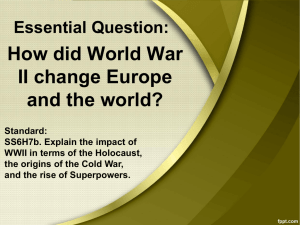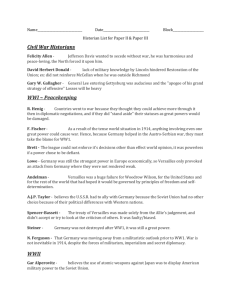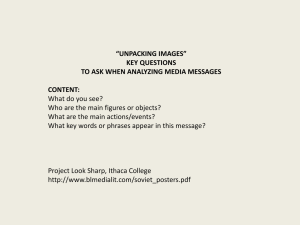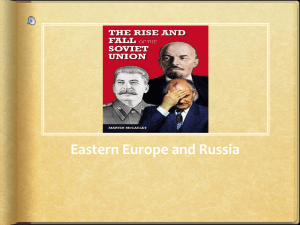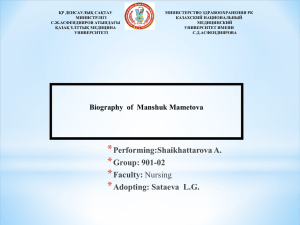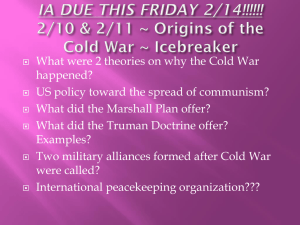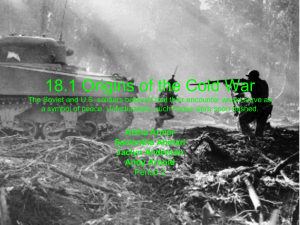Joon Block F HL Gifford To what extent were ideological differences
advertisement
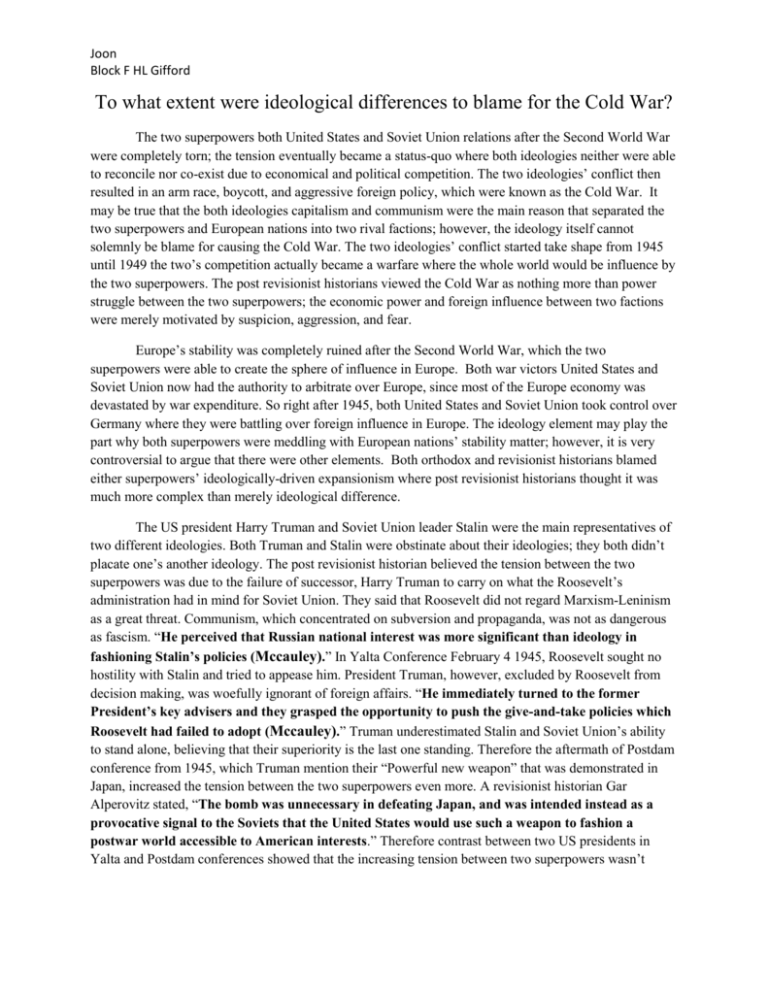
Joon Block F HL Gifford To what extent were ideological differences to blame for the Cold War? The two superpowers both United States and Soviet Union relations after the Second World War were completely torn; the tension eventually became a status-quo where both ideologies neither were able to reconcile nor co-exist due to economical and political competition. The two ideologies’ conflict then resulted in an arm race, boycott, and aggressive foreign policy, which were known as the Cold War. It may be true that the both ideologies capitalism and communism were the main reason that separated the two superpowers and European nations into two rival factions; however, the ideology itself cannot solemnly be blame for causing the Cold War. The two ideologies’ conflict started take shape from 1945 until 1949 the two’s competition actually became a warfare where the whole world would be influence by the two superpowers. The post revisionist historians viewed the Cold War as nothing more than power struggle between the two superpowers; the economic power and foreign influence between two factions were merely motivated by suspicion, aggression, and fear. Europe’s stability was completely ruined after the Second World War, which the two superpowers were able to create the sphere of influence in Europe. Both war victors United States and Soviet Union now had the authority to arbitrate over Europe, since most of the Europe economy was devastated by war expenditure. So right after 1945, both United States and Soviet Union took control over Germany where they were battling over foreign influence in Europe. The ideology element may play the part why both superpowers were meddling with European nations’ stability matter; however, it is very controversial to argue that there were other elements. Both orthodox and revisionist historians blamed either superpowers’ ideologically-driven expansionism where post revisionist historians thought it was much more complex than merely ideological difference. The US president Harry Truman and Soviet Union leader Stalin were the main representatives of two different ideologies. Both Truman and Stalin were obstinate about their ideologies; they both didn’t placate one’s another ideology. The post revisionist historian believed the tension between the two superpowers was due to the failure of successor, Harry Truman to carry on what the Roosevelt’s administration had in mind for Soviet Union. They said that Roosevelt did not regard Marxism-Leninism as a great threat. Communism, which concentrated on subversion and propaganda, was not as dangerous as fascism. “He perceived that Russian national interest was more significant than ideology in fashioning Stalin’s policies (Mccauley).” In Yalta Conference February 4 1945, Roosevelt sought no hostility with Stalin and tried to appease him. President Truman, however, excluded by Roosevelt from decision making, was woefully ignorant of foreign affairs. “He immediately turned to the former President’s key advisers and they grasped the opportunity to push the give-and-take policies which Roosevelt had failed to adopt (Mccauley).” Truman underestimated Stalin and Soviet Union’s ability to stand alone, believing that their superiority is the last one standing. Therefore the aftermath of Postdam conference from 1945, which Truman mention their “Powerful new weapon” that was demonstrated in Japan, increased the tension between the two superpowers even more. A revisionist historian Gar Alperovitz stated, “The bomb was unnecessary in defeating Japan, and was intended instead as a provocative signal to the Soviets that the United States would use such a weapon to fashion a postwar world accessible to American interests.” Therefore contrast between two US presidents in Yalta and Postdam conferences showed that the increasing tension between two superpowers wasn’t Joon Block F HL Gifford mainly due to ideological difference, rather it was Truman’s lack of experience and judgment had worsened the two relations. Germany was divided into two regions after the Postdam conference where one was occupied by democratic nations, and the other was occupied by USSR communist. Germany division represented the separation of Western and Eastern Europe, which it really highlighted the two different ideologies’ factions. Many argued that the ‘long telegram’ was one of mainly element that led to isolation policy and long term dislike between two superpowers. According to “George F. Kennan in his famous ‘long telegram’ of 22 February 1946, and in his anonymous article ‘The Sources of Soviet Conduct’ in July 1947 (Mccauley)” the orthodox historian believed that the blame was on Soviet Union’s ideology. From one of orthodox historians’ states, “The wellsprings of the Cold War are to be found in Marxism-Leninism with its doctrine of class struggle leading to revolution of a world scale (Mccauley),” clearly stating the cause for the Cold War started since Bolshevik revolution in 1917. By the end of 1948 the overwhelming majority of American and West European politicians had adopted George F. Kennan’s analysis. Orthodox historians regard the policies of the Soviet government vis-à-vis capitalist states as “Fundamentally hostile, merely tempered by cooperation when deemed necessary (Mccauley).” Michael Hart, also an orthodox historian, said, “The Cold War was caused by the military expansionism of Stalin and his successors. The American response… was basically a defensive reaction. As long as Soviet leaders clung to their dream of imposing Communism on the world, the West had no way (other than surrender) of ending the conflict. When a Soviet leader appeared who was willing to abandon that goal, the seemingly interminable Cold War soon melted away.” The occupation of East Germany and spread of communism in Eastern Europe all seemed as the nature of aggressive Soviet Expansionism. The division of Germany was an example to show ideological difference and separation of two superpowers influence. This led to iron curtain, Berlin blockade and airlift in 1948 and 1949 to demonstrate the ideological battle between two powers. US in the other hand tried to placate Soviet Union, “The Truman administration continued to seek cooperation with USSR, despite increasing exasperation at Soviet intransigence in the United Nations, and at their inability to pierce the ‘iron curtain (Mccauley).’” However, the revisionist historians’ argument was basically that the Soviet Union’s ideology expansion cannot be held in account for hostile behavior. They believed that Soviet Union’s stability was completely ruin after the Second World War where they narrowly escaped defeat with its enormous human and material losses meant that by 1945, it was near economic ruin. Therefore confronted by their rival ideology and prosperous nation United States, the Soviet Union was intimidated by their power influence. In order to prevent any threat happening from Germany they needed to create a buffer zone, “Its security needs led it to seek governments in contiguous state which were not anti-Soviet and to ensure that no military threat ever emanated again from German soil (Mccauley).” In July 1947 the United States suggested the Soviet Union to reconstruct the Europe’s economic stability, the Marshall Plan. However, after all the attempts to have partnership, the United States had no choice but to have priority to use the containment of communist expansionism in order to protect non-communist European states because Soviet Union refused all these offers of cooperation. The Soviet Union couldn’t let that happen because, “Threat to its security interests in eastern and southeastern Europe, particularly as American trade and investment were frequently accompanied by militant anti-communism (Mccauley).” Therefore despite the fact that there was ideological difference, the US tried to sort out Joon Block F HL Gifford their differences and tried to placate Soviet Union; however, for Soviet Union it was strategically necessary to act against US foreign policy for their national safety. However, the ideological difference did play significant in the Marshall Plan because it was found in the American economic and political system. They said, “The liberal capitalist US economy needed ever increasing trade and investment opportunities to overcome its endemic weaknesses, this in turn implied the expansion of American political influence (Mccauley).” The Marshall Plan was designed to create an informal American empire in Europe and thereby to extend American political influence over the USSR itself. “US involvement in the war against Japan and Germany was the desire to maintain and to expand where possible the US share in the world economy, since Japan and Germany were in the process of establishing autarkic empires (Mccauley).” Roosevelt and Truman and their advisors already predicted the threat of Soviet Expansionism, and that they tried to restrain the Soviets from changing the international order in a way that would have been as dangerous to Western interests. Therefore Marshall Plan then led to Truman Doctrine, and establishment of NATO in 1949, which not only did it influence Europe to be under control by American imperialism, but also did not support Soviet Union because the United States implanted anti-communism propaganda. American pressure and the Western decision to form blocs resulted in the Soviet Union seeking greater political conformity in eastern and south-eastern Europe, which it was an ideological struggle in political and economical elements. It is much reasonable to agree with Post-revisionist historians’ argument because it has both Western and Soviet Union’s perspective. Orthodox and post revisionist historians would slightly be onesided where orthodox historians were influenced during the beginning of the Cold War era, and Post revisionist historians were popular when the United States was involved in Vietnam War. “The weaknesses of the orthodox and revisionist analyses are evident: the former pays little attention to the legitimate security needs of the USSR, while the latter ignores Soviet behavior which gave rise to shifts in American policy (Mccauley).” Post-revisionist historians interpretations sought to avoid the polarities of “Blame-it-all-on-the Soviets” or “blame-it-all-on-the-Americans.” They also acquired the Soviet’s historian knowledge when the Soviet archive was accessible. They emphasized the element “Fear” and “Apprehension” as the main reason for leading the two superpowers to the Cold War as they both sought for military, politic, economic superiority over one another, and would simply justify it as an ideological difference. Though the world was divided by two ideologies, the causes of the Cold War cannot solemnly be interpreted by ideological difference. That is why the Cold War is viewed differently by many historians such as orthodox, revisionist, and post revisionist historian. There are many substantial evidences that support those interpretations of the Cold War, and all of them are respectfully recognized by other historians. However, believe that the Cold War mainly because of fear of either superpowers being dominated by one another, such anticipation risen to extreme case where both United States and Soviet Union hyperbolically creating two huge factions, and separating themselves by ideological difference. Mccauley, Martin. Origins of the Cold War (Seminar Studies in History). Edinburgh: Longman Group United Kingdom, 1983. Print.
